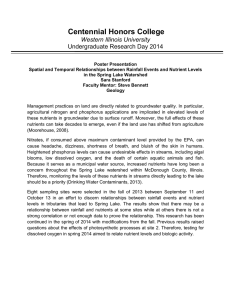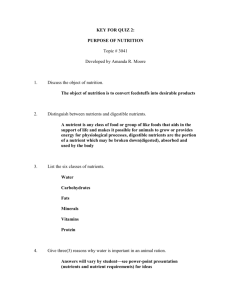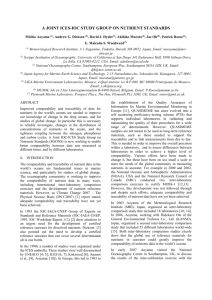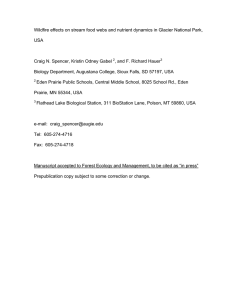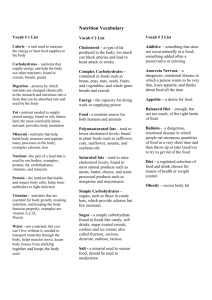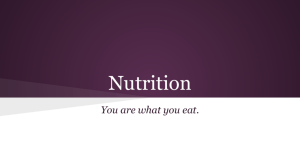INFORMATION DOCUMENT IOC/INF-1260 Paris, 11 May 2009
advertisement
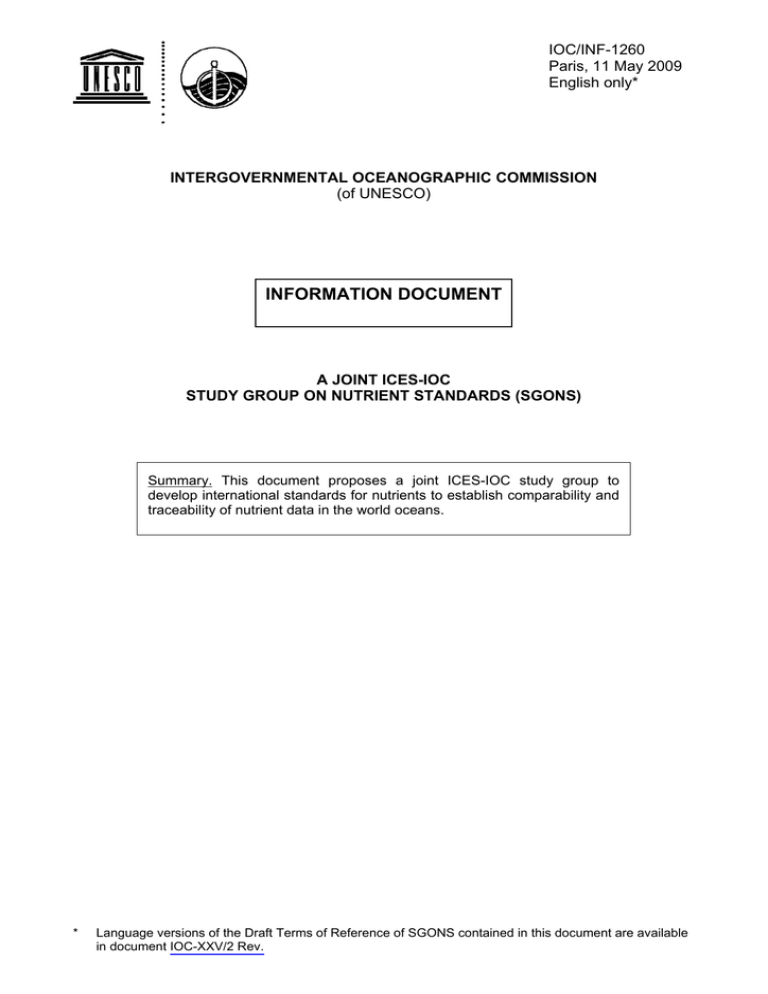
IOC/INF-1260 Paris, 11 May 2009 English only* INTERGOVERNMENTAL OCEANOGRAPHIC COMMISSION (of UNESCO) INFORMATION DOCUMENT A JOINT ICES-IOC STUDY GROUP ON NUTRIENT STANDARDS (SGONS) Summary. This document proposes a joint ICES-IOC study group to develop international standards for nutrients to establish comparability and traceability of nutrient data in the world oceans. * Language versions of the Draft Terms of Reference of SGONS contained in this document are available in document IOC-XXV/2 Rev. IOC/INF-1260 Introduction The comparability and traceability of nutrient data in the world’s oceans are fundamental issues in marine science, and particularly for studies of global change. The oceanography community has been continuing to improve comparability of nutrient data from the world’s oceans in many ways, including international inter-comparison exercises and also development of nutrient reference materials. However, as Climate Change 2007 – The Physical Science Basis (IPCC2007) report stated, adequate comparability and traceability have not yet been achieved. The IPCC2007 report comments as follows on nutrient comparability: "Using the same data set extended to the world, large regional changes in nutrient ratios were observed but no consistent basinscale patterns. Uncertainties in deep ocean nutrient observations may be responsible for the lack of coherence in the nutrient changes. Sources of inaccuracy include the limited number of observations and the lack of compatibility between measurements from different laboratories at different times (Bindoff et al., 2007)". In 1993 the IOC-IAEA-UNEP Group of Experts on Standards and Reference Materials (IOCIAEA-UNEP, 1993, IOC Workshop Report 112) drew attention to an urgent need for the development of certified reference seawater for dissolved nutrients. Dickson (2003) also pointed out the need to develop a certified reference seawater that can cover several determinands all in one bottle. In the 1990s a number of studies were organized under the ICES umbrella. These studies were well documented (UNESCO 1965, 1967; ICES 1967, 1977; Kirkwood 1991; Aminot et al., 1995 and Aoyama, 2006). In Europe, this led to the establishment of the Quality Assurance of Information for Marine Environmental Monitoring in Europe (QUASIMEME, Topping, 1997). QUASIMEME is a useful programme for validating the procedures of individual laboratories for a wide range of determinands. However, this programme is inadequate for supporting the traceability that is required to link measurements from day to day in order to improve the overall precision within a laboratory, or to achieve a known level of comparability between different laboratories. In 2000 and 2002, the National Oceanic and Atmospheric Administration (NOAA), USA and the National Research Council of Canada (NRC) conducted two inter-comparison exercises to certify MOSS-1 (Willie and Clancy, 2000; Clancy and Willie, 2003). However, despite individual efforts, adequate comparability and traceability of nutrient data have not yet been achieved. Various efforts have been made to change it, but these have been on too small a scale to meet the needs of the global community in measuring nutrients in seawater. In 2003 Michio Aoyama of the Meteorological Research Institute (MRI), Japan, organized an inter-laboratory comparison study that included 18 laboratories (Aoyama, 2006, Aoyama et. al, 2007). In 2006 Dr Aoyama, working with Hidekazu Ota of the General Environmental Technos Co., Ltd. (KANSO), Japan, organized a second inter-comparison study that included 55 different laboratories world-wide (Aoyama et al., 2008). Both inter-laboratory comparison studies clearly show that the global use of reference materials for nutrients in seawater would greatly improve the comparability of nutrients data in the world’s oceans. In early 2007 Michio Aoyama visited the National Oceanography Centre in Southampton, UK, to discuss the results of the inter-calibration exercise with the European participants in the inter-calibration exercise as well as other interested nutrient chemists. As a follow-up to this meeting, an International Workshop on Chemical Reference Materials in Ocean Science was held in Tsukuba, Japan, on 29 October to 1 November 2007. It focused on the measurement of nutrients and of ocean CO2 parameters, and the current status of available chemical reference materials, particularly for nutrient references in ocean science. The participants agreed to start a collaborative programme, called the International Nutrients Scale System (INSS), with the aim of IOCINF-1266 – page 2 establishing global comparability and traceability of nutrient data. The agreements at this workshop in Tsukuba 2007 marked a turning point in the history of nutrient comparability. In February 2009, the INSS group held a workshop at UNESCO in Paris to advance international collaboration in establishing global comparability of nutrient data in the world ocean and to discuss future tasks (2009 International Nutrients Scale System international workshop, Paris, 10–12 February 2009). An “International Nutrients Scale System (INSS)” in seawater was agreed as the appropriate way to achieve this goal. A joint ICES-IOC study group is proposed to develop international standards for nutrients to establish comparability and traceability of nutrient data in the world oceans. Proposed Terms of Reference for this group are given below. Draft Terms of Reference Joint ICES-IOC Study Group on Nutrient Standards (SGONS) General Description of Activities ICES and IOC will provide stewardship for the INSS study group for a period of three (3) years (2009–2011). The INSS study group will undertake specific tasks (as listed in Specific Terms of Reference, below) to develop reference materials for nutrients in seawater (RMNS) and measurement protocols to improve the comparability and traceability of nutrient data in the world’s oceans. Specific Terms of Reference (i) Develop and establish reference materials for nutrients in seawater (RMNS) collaborating with producers of currently available RMNS. Primary determinands are nitrate, nitrite, phosphate and silicate. (ii) Collaborate and encourage National Metrology Institute of Japan to complete certification of RMNS for nitrate, nitrite, phosphate and silicate. (iii) Develop new sampling and measurement protocols using the RMNS. (iv) Carry out an international collaboration exercise to verify the stability of the reference materials and test the proficiency of the new protocols. (v) Complete and publish a revised nutrients analysis manual. (vi) Distribute 10,000 bottles of RMNS to laboratories measuring nutrients as part of the CLIVAR Repeat Hydrography Program to construct a global nutrient dataset referenced to the new RMNS. (vii) Promote the use of RMNS to aim for global acceptance in order to enable reliable comparability between global nutrient data sets, and to investigate the feasibility of expanding RMNS to include ammonium and dissolved organic matter. (viii) Encourage the collaborations with communities of chemical reference materials for ocean sciences such as carbonate system RMs for DIC, TA and pH, and also for dissolved oxygen in seawater. IOCI/INF-1260 – page 3 Financial Implications Extra-budgetary funding will be found to implement the work of the group. Twenty (20) scientists from 10 countries have agreed to participate in the inter-laboratory comparison exercises for three years at their own cost. Funding from the IOC regular programme budget of US$ 5,000 per year to hold regular steering committee meetings is requested. ICES delegates will nominate the ICES participants to the group. They will participate on national expenses. ICES offers the ICES Techniques in Marine Environmental Sciences as on outlet for the work of the group. It is free of charge and has an ISSN. References Aminot, A. and D. S. Kirkwood, 1995: Report on the results of the fifth ICES Intercomparison Exercise for Nutrients in Seawater, ICES Cooperative Research Report No. 213, 79 pp. Aoyama, 2006: 2003 Intercomparison Exercise for Reference Material for Nutrients in Seawater in a Seawater Matrix, Technical Reports of the Meteorological Research Institute No. 50, 91pp Aoyama, M., S. Becker, M. Dai, H. Daimon, L. I. Gordon, H. Kasai, R. Kerouel, N. Kress, D. Masten, A. Murata, N. Nagai, H. Ogawa, H. Ota, H. Saito, K. Saito, T. Shimizu, H. Takano, A. Tsuda, K. Yokouchi, A. Youenou, 2007: Recent comparability of Oceanographic Nutrients Data: Results of a 2003 Intercomparison Exercise using Reference Materials, Analytical Science, 23, 1151-1154. Aoyama M., J. Barwell-Clarke, S. Becker, M. Blum, Braga E. S., S. C. Coverly,E. Czobik, I. Dahllof, M. H. Dai, G. O. Donnell, C. Engelke, G. C. Gong, Gi-Hoon Hong, D. J. Hydes, M. M. Jin, H. Kasai, R. Kerouel, Y. Kiyomono, M. Knockaert, N. Kress, K. A. Krogslund, M. Kumagai, S. Leterme, Yarong Li, S. Masuda, T. Miyao, T. Moutin, A. Murata, N. Nagai, G.Nausch, M. K. Ngirchechol, A. Nybakk, H. Ogawa, J. van Ooijen, H. Ota, J. M. Pan, C. Payne, O. PierreDuplessix, M. Pujo-Pay, T. Raabe, K. Saito,K. Sato, C. Schmidt, M. Schuett, T. M. Shammon, J. Sun, T. Tanhua, L. White, E.M.S. Woodward, P. Worsfold, P. Yeats, T. Yoshimura, A.Youenou, J. Z. Zhang, 2008: 2006 Intercomparison Exercise for Reference Material for Nutrients in Seawater in a Seawater Matrix, Technical Reports of the Meteorological Research Institute No. 58, 104pp. Bindoff, N.L., J. Willebrand, V. Artale, A, Cazenave, J. Gregory, S. Gulev, K. Hanawa, C. Le Quéré, S. Levitus, Y. Nojiri, C.K. Shum, L.D. Talley and A. Unnikrishnan, 2007: Observations: Oceanic Climate Change and Sea Level. In: Climate Change 2007: The Physical Science Basis. Contribution of Working Group I to the Fourth Assessment Report of the Intergovernmental Panel on Climate Change, edited by S. Solomon et al., Cambridge University Press, Cambridge, United Kingdom and New York, NY, USA. Clancy, V. and S. Willie, 2003: NOAA/NRC Intercomparison for Nutrients in Seawater, NOAA Technical Memorandum NOS NCCOS CCMA 158, 32 pp. Dickson, A.G., J.D. Afghan and G.C. Anderson, 2003: Reference materials for oceanic CO2 analysis: A method for the certification of total alkalinity. Marine Chemistry, 80, 185-197. [ICES] International Council for the Exploration of the Sea, 1967: Report on the analysis of phosphate at the ICES intercalibration trials of chemical methods held at Copenhagen, 1966. ICES CM 1967/C: 20. [ICES] International Council for the Exploration of the Sea, 1977: The International Intercalibration Exercise for Nutrient Methods, ICES Cooperative Research Report No. 67. 44 pp. IOCINF-1266 – page 4 [IOC] Intergovernmental Oceanographic Commission, 1993: IOC–IAEA–UNEP Group of Experts on Standards and Reference Materials (GESREM), IOC workshop report No.112 12 pp. Kirkwood, D. S., A. Aminot, and M. Perttila, 1991: Report on the results of the fourth ICES Intercomparison Exercise for Nutrients in Seawater, ICES Cooperative Research Report No. 174, 83 pp. Topping, G., 1997: QUASIMEME: quality measurements for marine monitoring. Review of the EU project 1993-1996, Marine Pollution Bulletin, 35, 1-201. [UNESCO] United Nations Educational, Scientific and Cultural Organization, 1965: Report on the intercalibration measurements in Copenhagen, 9–13 June 1965, UNESCO Technical Papers in Marine Science, No. 3. 14 pp. [UNESCO] United Nations Educational, Scientific and Cultural Organization, 1967: Report on intercalibration measurements, Leningrad, 24–28 May 1966, Copenhagen, September 1966, UNESCO Technical Papers in Marine Science, No. 9. 114 pp. Willie, S. and V. Clancy, 2000: NOAA/NRC Intercomparison for Nutrients in Seawater, NOAA Technical Memorandum NOS NCCOS CCMA 143, 176 pp. Intergovernmental Oceanographic Commission (IOC) United Nations Educational, Scientific and Cultural Organization 1, rue Miollis 75 732 Paris Cedex 15, France Tel.: +33 1 45 68 10 10 Fax: +33 1 45 68 58 12 http://Ioc.unesco.org
